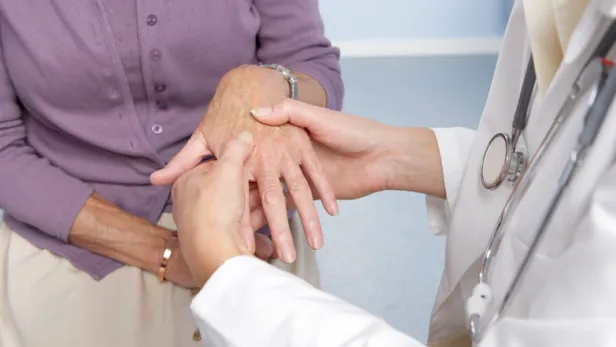Disease Education Information
Ankylosing spondylitis (pronounced “ang-kill-LOH-sing spawn-duh-LY-tus”) is an uncommon form of arthritis that primarily affects the spine. It is a chronic (long-term) condition that causes back pain and stiffness in the back, neck and other areas of the body. It typically starts in late adolescence or early adulthood, before the age of 45. Over time, the vertebrae (bones of the spine) can fuse together. While there is no cure yet, some treatments may help reduce the symptoms and possibly slow the progression of the disease. Early diagnosis and intervention are key.
- What is Ankylosing Spondylitis?
Spondylitis refers to inflammation of the spine, and ankylosis references the fusion of two bones into one. Ankylosing spondylitis can cause pain and stiffness that usually starts in the low back. As the disease progresses, it can affect neck, shoulders, buttocks, hips and heels. Normal, daily activities can be impacted, including bending over to put on socks and shoes, for example. It may even affect the joints between the spine and ribs, resulting in a hunched over posture and difficulty breathing.
- What Causes It? And Who is at Risk?
There is no known specific cause. Ankylosing spondylitis is relatively rare, affecting about 1 in 1,000 people. It is believed that people with the gene called HLA-B27 are at the greatest increased risk for developing ankylosing spondylitis, not everyone with the gene develops the condition.
Ankylosing spondylitis is more common in men. The disease can occur at any age; however, onset generally occurs in late adolescence or early adulthood, between the ages of about 20 and 40. The majority of patients with ankylosing spondylitis experience symptoms before they reach 30 years of age, and only about 5% present with symptoms after age 45 years.
- What are the Signs and Symptoms?
The most common early sign and symptom of ankylosing spondylitis is pain or stiffness in the lower back, which can be worse in the mornings or after periods of inactivity. Additionally, symptoms may improve after activity or exercise. Back pain from other causes tends to worsen with exercise, but people with ankylosing spondylitis can feel worse without regular exercise.
Neck pain and fatigue are other common symptoms.
Other possible symptoms may include fever, loss of appetite, weight loss, inflammation of the bowels or eyes. Compression fractures and heart problems are possible complications of the condition.
- How is It Diagnosed?
There is no single test that can diagnose ankylosing spondylitis. A doctor or specialist (such as a rheumatologist) will diagnose the condition after discussing a patient’s medical history and symptoms, performing a physical examination, and evaluating imaging tests such as X-rays and/or MRI. Doctors may perform blood tests as well.
- How is Ankylosing Spondylitis Treated?
There is currently no cure for ankylosing spondylitis. However, there are treatments that may help reduce joint pain and possibly slow the damage to the spine or other affected joints.
A patient’s treatment will depend on the symptoms experienced and the severity of the condition. Treatment options may include:
- Medication, such as anti-inflammatory drugs, pain relievers, biologic drugs, corticosteroids;
- Physical therapy and exercise, to promote range-of-motion stretching and maintain flexibility, and;
- Surgery.
Hot baths, heat, and massages may also help relieve pain.
Area of Focus: Inflammation & Immunology
Ankylosing Spondylitis is a focus of our Inflammation & Immunology Therapeutic Area.
Visit Our Inflammation & Immunology Site DetailsClinical Trials
We proudly partner with thousands of study sites and tens of thousands of trial participants around the world. It's these clinical trials that lead to life-changing medicines.
Go to Pfizer Clinical Trials Site DetailsReferences
1. Stanford Health Care. Ankylosing Spondylitis. https://stanfordhealthcare.org/medical-conditions/bones-joints-and-muscles/ankylosing-spondylitis.html.
2. Arthritis Foundation. Axial Spondyloarthritis. https://www.arthritis.org/diseases/ankylosing-spondylitis.
3. Harvard Health. Ankylosing Spondylitis. www.health.harvard.edu/a_to_z/ankylosing-spondylitis-a-to-z.
4. Johns Hopkins Arthritis Center. Ankylosing Spondylitis: Symptoms, Diagnosis and Treatment. www.hopkinsarthritis.org/arthritis-info/ankylosing-spondylitis/.
5. American College of Rheumatology. Spondyloarthritis. www.rheumatology.org/I-Am-A/Patient-Caregiver/Diseases-Conditions/Spondyloarthritis.
6. Taurog, Joel D., et al. “Ankylosing Spondylitis and Axial Spondyloarthritis.” New England Journal of Medicine, vol. 374, no. 26, 2016, pp. 2563–2574., doi:10.1056/nejmra1406182.
7. National Institutes of Health. Ankylosing Spondylitis. https://www.niams.nih.gov/health-topics/ankylosing-spondylitis#tab-risk
8. UpToDate. Clinical manifestations of axial spondyloarthritis (ankylosing spondylitis and nonradiographic axial spondyloarthritis) in adults.


